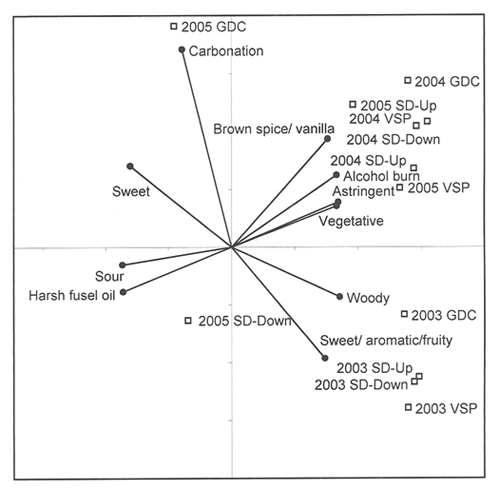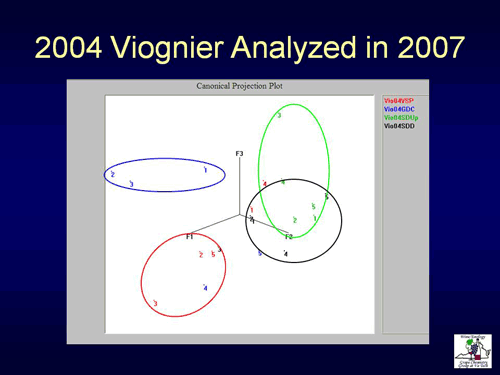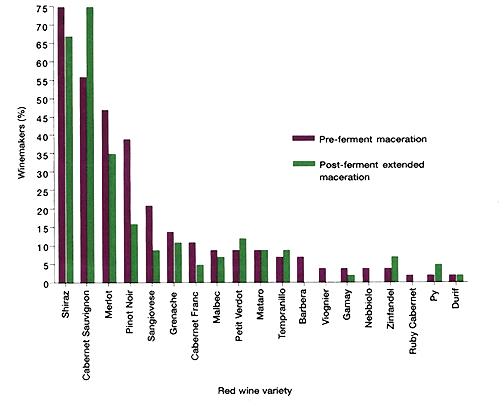Enology Notes #142
Enology Notes #142, July 18, 2008 - Link to PDF
To: Winemakers and Perspective Winemakers
From: Bruce Zoecklein, Head, Enology-Grape Chemistry Group, Virginia Tech
Subjects Discussed in Enology Notes #142:
- Pre-Harvest and Harvest Fermentable Nitrogen Analysis (continued)
- Effects of Training Systems on Viognier Fruit and Wine Composition
- HACCP Planning and the 2008 Harvest
- Red Wine Maceration Considerations
- Délestage Publication Online
- EnologyAccess.org
1. Pre-Harvest and Harvest Fermentable Nitrogen Analysis (continued). The Enology Service Laboratory at Virginia Tech performs chemical, physical, microbiological, and sensory analysis on juice and wines from around the country and, indeed, the world.
As outlined in previous editions of Enology Notes (available at www.vtwines.info, click Enology Notes Index), Ken Hurley, Director of the Enology Service Laboratory at Virginia Tech, conducted an analytical survey of juice samples during the 2007 harvest season. The analyses included yeast available nitrogen (YAN), ammonia, and arginine. Nitrogen (N) is a limiting nutrient in grape must that impacts yeast growth, the capacity to ferment, and the production of sensorially-important metabolites that impact wine quality (See Enology Notes # 141). Possibly as a result of the YAN assays we conducted, we have noted a decline in the incidence of sulfur-like off odors in 2007 evaluated wines.
a. Nitrogen assays for the 2008 season. The Enology Service Laboratory will offer pre-harvest and harvest fermentable nitrogen analysis again for the 2008 season. The procedure is as follows:
- Email the laboratory at Enology.Services@vt.edu to request processing bags and/or bottles (fruit analysis vs. juice).
- Include name, company, mailing address, and the number of sampling kits required.
- Collect juice samples at harvest, or grape berry samples from the vineyard pre-harvest. Representative vineyard samples can be collected up to 5 days pre-harvest.
- Fill sample bottles to the indicated level, and mix thoroughly to dissolve preservative.
- Ship samples next day/early morning delivery to the Enology Service Laboratory (shipping delays impact analysis results).
- Results will be posted on client’s secure website within 24 hours.
Fermentable Nitrogen Analysis is $25. Juice panels (Brix, nitrogen, malic acid, pH, and TA) are $60 per sample. For additional information on other available analyses and analytical panels, please see the Enology-Grape Chemistry website at www.vtwines.info.
Complete information regarding grape sampling and fruit processing can be found on the Enology-Grape Chemistry Group website (www.vtwines.info) under Online, click Publications, click Maturity Evaluation for Growers.
2. Effects of Training Systems on Viognier Fruit and Wine Composition. The following review is adapted, in part, from a study conducted by myself, Dr. Tony Wolf, and others, titled: Effects of Training Systems on Viognier Fruit and Wine Composition, Am. J. Enol. Vitic. Vol. 59:1 (Zoecklein et al. 2008). The study was designed to answer the following question: What are the influences on a training system of Viognier fruit volatiles and wine aroma and flavor?
A significant volume of research has advanced our understanding of how various viticultural practices, such as crop level, crop exposure (Bergqvist et al. 2001, Zoecklein et al. 1998), leaf area to crop ratio (Kliewer and Dokoozlian 2005), shoot density, and training systems (Reynolds and Wardle 1991) affect grape and wine components, including volatile compounds and sensory response. However, Viognier has received relatively limited attention, despite its importance and popularity. This study was based on the following:
- VSP training has emerged as a common training system.
- Heavy canopies, with non-uniform leaf and fruit exposure, can impact fruit volatile components and adversely affect fruit quality.
- Cost of grape production is relatively high, therefore growers must seek increased efficiency without negatively impacting grape and wine quality.
- Canopy division is one tool to deal with excessive vine size and poor canopy characteristics.
a. Sensory evaluation of Viognier wines. We conducted a number of sensory evaluations on Viognier wines produced from this study, including principal component analysis (PCA). With this tool, the number of variables is reduced such that the first principal component statistically identifies or explains most of the variability in the data (Meilgaard et al. 1991). The second component, which is not correlated with the first, explains the majority of the remaining variance.
A graphic portrayal of the principal components may be used to illustrate relationships among important wine attributes. The principal component analysis for aroma of Viognier produced in this study is presented below (Figure 1). The two axes represent a statistical method to illustrate relationships. Emanating from the central origin are vectors, or lines, each representing a sensory attribute. The length of the vector is an indication of the influence of that attribute: short vectors indicate attributes of relatively low importance. Close alignment of a vector with the principal component axis indicates a high correlation between the attribute represented by the vector and the variability explained by the principal component.

Figure 1. Principal component analysis (PCA) of aroma of Viognier wines produced on Geneva Double Curtain (GDC), Smart-Dyson (SD) Down or Up, and Vertical Shoot Positioned (VSP) training in 2003 through 2005.
Aroma analysis indicated treatments accounted for an average of 59% of the variance in aroma for all three seasons (Figure 1). GDC wines were distinguished by overall aroma intensity, and fruity, sweet vanilla aromas. Aroma descriptors appeared to cluster around growing season. For example, wines produced in the cool, wet, 2003 vintage with limited fruit Brix were generally characterized by vegetative aromas, while those produced in the drier and warmer 2004 vintage had higher fruit and overall aroma intensity.

Figure 2. Principal component analysis (PCA) of flavor of Viognier wines produced on Geneva Double Curtain (GDC), Smart-Dyson (SD) Down or Up, and Vertical Shoot Positioned (VSP) training in 2003 through 2005.
The first and second principal components of the flavor analysis accounted for 63% of the variance among wines produced from different training systems (Figure 2). Wine flavor sensory profiles were also clustered around season. Despite the limited fruit maturity attained in 2003, wine flavors were characterized as sweet, aromatic and fruity. The higher Brix fruit in 2004 produced wines with brown spice and vanilla flavor descriptors.
b. Electronic nose evaluation of Viognier from different training systems. The Enology-Grape Chemistry Group has conducted several studies using electronic nose technology to evaluate the impact of grape growing and winemaking parameters. (See Enology Notes Index and On-Line Publications at www.vtwines.info.)
The electronic nose (EN or Enose) is an analytical tool composed of sensors that analyze volatile compounds, some of which may contribute to aroma/flavor. Several classes of ENs exist, including quartz micro-balanced sensors (QMS), conducting polymer sensors, metal oxide sensors (MOS), and surface acoustic wave (SAW) based sensors. Selectivity, sensitivity, and detection of volatile compounds differ according to sensor type.
Electronic nose evaluations were conducted on bottled Viognier wines from this study using a conducting polymer-based Enose system. Figures 3 and 4 show canonical projection plot separations of volatile compounds in Viognier wines determined by electronic nose measurements. Canonical plots are a statistical representation for looking at linear combinations of variables and separating them in a three-dimensional space.

Figures 3 and 4. Canonical projection plots of Viognier wines produced on Geneva Double Curtain (GDC), Smart-Dyson (SD) Down or Up, and Vertical Shoot Positioned (VSP) training in 2004 (top) and 2005 (bottom) analyzed in 2007.

The 2004 bottle-aged GDC, VSP and SD wines were clearly separated (circles do not overlap) based on volatile compounds. SD-Up and SD-Down were similar in the aroma profile as indicated by the overlapping circles.
Bottled-aged wines produced in 2005 showed some overlap in the volatiles from the GDC and SD-Up, as depicted. The Enose results of these vintages reflect the overall sensory differences noted in the principle component analysis. These evaluations further demonstrate the utility of electronic nose technology as a practical monitoring device.
c. Summary of Viognier research results.
- GDC training increased crop per vine and crop load, but decreased crop per m of cordon relative to VSP-trained vines.
- SD training similarly increased crop per vine while generally not depressing the corresponding crop load, relative to VSP.
- Both the SD and GDC systems tended to have higher fruit glycosides (in part, aroma/flavor precursors) and free volatiles than did the non-divided VSP.
- Despite higher crop loads associated with the GDC vines, triangle difference testing generally did not distinguish wines made from GDC and VSP systems.
- Wines produced from SD-trained vines differed in flavor, but not aroma.
- Generally, wine produced from GDC-trained vines differed from SD wines in aroma and flavor. PCA demonstrated GDC-produced wines were distinguished by overall aroma intensity and fruity, sweet, vanilla aromas.
- Electronic nose was able to distinguish among wines 2 and 3 years post-bottling produced by the four training systems.
- Despite the increased yields, GDC and SD-trained vines produced wines of comparable, if not superior, sensory attributes to VSP-trained vines.
3. HACCP Planning and the 2008 Harvest. HACCP is a system for assuring product quality control from beginning to end, through the identification and monitoring of the Critical Control Points (CCPs) during processing (see previous Enology Notes at www.vtwines.info).
HACCP plans integrate production (of both grapes and wines) with chemical, physical, microbiological, and sensorial analyses to help assure quality and style control. HACCP-like plans are designed to identify where CCPs occur, and establish control and monitoring measures.
Wine industry HACCP-like plans begin with establishing a processing chart or flow diagram, that starts in the vineyard and ends with movement of wine through the distribution network. At each step, CCPs are identified and ranked in terms of their importance, and a corresponding list of analytical control measures is established. Properly prepared, the HACCP plan helps to answer several basic questions:
- when specific monitoring is needed and during which processing steps
- why monitoring is important
- where monitoring fits into the winemaker’s processing protocol
- how results are interpreted
- what the expected range of values for chemical, physical, microbiological and sensory reviews are
- what corrective measures are needed if results do not fall within specifications.
Results must be regularly assessed to determine if additional steps or corrective steps are required.
a. HACCP planning and fruit ripeness indicators. The procedure outlined above can be important in maturity assessment as a function of the following. Each item has been outlined or discussed in previous editions of Enology Notes at www.vtwines.info.
Fruit maturity considerations:
- use goal-driven maturity decisions
- maturity indicators should correlate to aroma/flavor and phenol suppleness
- fruit sampling methods are critical
- degree of asymmetric ripening in clusters and berries can have a profound influence
- sensory evaluation of skin, stem, pulp, and seed phenolic maturity
- chew skins, save reference samples from previous sampling dates to compare
- seed maturity (color, texture, and brittleness)
- seed numbers
- relationship between berry weight, shriveling, and engustment (rapid increase in free aroma/flavor volatiles)
- relationship between berry weight and physiological maturity
- berry softness and diffusion of pulp
- estimation of berry size
- sugar per berry vs. simple increases in Brix
- Brix and aroma/flavor, phenol development do not necessarily correlate
- changes in pH are not necessarily a function of berry ‘age’, and relate to K+ and vigor
- Brix to alcohol conversion rate
- TA, pH, and potential structural balance
- Tartaric/malic ratio
b. HACCP planning and wine processing. Each item listed below should be carefully reviewed prior to harvest. Each has been outlined or discussed in previous editions of Enology Notes at www.vtwines.info.
Important red wine fermentation critical control points to consider:
- Brix to alcohol conversion rate/chaptalization
- alcohol and structural balance
- must TA, tartaric/malic ratio, pH
- TA reduction methods
- tannin addition, can add mid-palate depth
- fermentable nitrogen, not a matter of simple fermentation sticking
- yeast(s)
- sulfur dioxide
- role of oxygen
- size and shape of fermentation tank
- open vs. closed fermentation tanks
- temperature of liquid and cap
- MLF, strain(s), timing, volume of inoculums
- use of wood
- punch down, pump over, irrigation systems, sweeper tanks, délestage, alcohol at time of dejuicing (Vintner’s Corner 13:2)
- post-fermentation maceration
- free run vs. press run
- multiple press fractions
4. Red wine maceration considerations. One overarching concern in red wine production is tannin management. At a meeting I attended in Oregon, Dr. Doug Adams of UC-Davis reported a study he and colleagues conducted on Pinot noir. Evaluating a number of commercial growers and wine producers in CA and OR, they found the following:
- Skin tannin concentrations of Pinot noir fruit differed by a factor of 6, depending on the growing region.
- Extractable seed tannin concentrations differed by a factor of 2.
- Wine tannin concentrations differed by a factor of 30.
This highlights the variability of extraction of fruit tannins during processing. Two important red wine processing variables include cold soak and extended post-fermentation maceration (see previous editions of Enology Notes). The following demonstrates the percentage of winemakers using pre- and post-fermentation maceration in Australia for selected varieties.

Figure 5. The percentage of Australian winemakers using pre-fermentation maceration and post-fermentation extended maceration (adapted from Crushing and Pressing: Research responds to determine extended maceration strategies for red wines. The Australian & New Zealand Grapegrower and Winemaker, June, 2008).
This highlights the interest in these two red wine processing steps among Australian producers. As previously reported, we are using electronic nose technology to evaluate the impact of cold soak on volatiles. Cold soak may improve color, color stability and aromatic potential (See Enology Notes Index and On-Line Publications at www.vtwines.info).
Extended post-fermentation maceration attributes reported include improved color stability and additional tannin structure and depth.
An important consideration is that fruit phenols, such as tannins, are relatively hydrophobic, a feature that limits solubility in the early stages of fermentation. As fermentation progresses, more tannin is extracted as the alcohol concentration increases.
Thus, during fermentation the medium changes from entirely aqueous (all water and, therefore, very polar) to partial alcohol with less water and less polarity. Tannins, being less polar than water, are more easily extracted as alcohol concentration increases. This may result in a quantitative and qualitative change and becomes very important when the phenolic elements of the fruit are not fully ‘mature’.
5. Délestage Publication Online. The Effects of Délestage with Partial Seed Deportation on Merlot and Cabernet Sauvignon Wines (Zoecklein et al. 2007) is posted online (www.vtwines.info). This study compared délestage (rack and return) involving partial seed deportation, with Merlot produced by manual cap punching for three seasons, and Cabernet Sauvignon produced by mechanical punch-down (pigeage) systems for one season. Fermentation reduced the percentage of color from monomeric pigments and increased the percentage of color from polymeric pigments for all treatments. Délestage wines generally had a higher percentage of color derived from large polymeric pigments than manual cap-punched or pigeage wines. Total glycosides (in part, aroma/flavor precursors) increased during cold soak and fermentation, and were in greater concentration in the manual cap-punched Merlot wines. Triangle difference sensory analysis demonstrated Merlot wines differed in aroma and/or flavor in two of three vintages. Cabernet Sauvignon wines were perceived to differ in both aroma and flavor.
This on-line publication provides the full details of the study. General information regarding this production technique is available at www.vtwines.info. Click Enology Notes, then Enology Notes Index.
6. EnologyAccess.org. Dr. Linda Bisson, UC-Davis, is heading a group to create EnologyAccess.org. The goal is the development of a comprehensive website that will serve enology researchers and winery personnel. The site will also serve as a resource for information and technical advice, and facilitate adoption of innovative practices by winery personnel.
The site will:
- Be a single site resource for information on a broad array of topics of interest to enologists and winemakers.
- Organize available information from multiple institutions at one location.
- Provide a resource for continuing education programs.
- Serve as an interactive site for real-time problem solving.
- Provide documented training in various areas.
- Provide timely and topical information on current issues.
This site will feature an inaugural webinar by Dr. Jim Harbertson on August 27, 2008, entitled “A technical guide to the Adams/Harbertson tannin assay.” The Enology-Grape Chemistry Group and Virginia Tech are among the collaborators in this effort. More to follow.
Literature cited
Bergqvist, J., N. Dokoozlian, and N. Ebisuda. 2001. Sunlight exposure and temperature effects on berry growth and composition of Cabernet Sauvignon and Grenache in the central San Joaquin Valley of California. Am. J. Enol. Vitic. 52:1-7.
Kliewer, W.M., and N.K. Dokoozlian. 2005. Leaf area/crop weight ratios of grapevines: Influence on fruit composition and wine quality. Am. J. Enol. Vitic. 56:170-181.
Reynolds, A.G., and D.A. Wardle. 1991. Impact of training system, vine spacing, and basal leaf removal on the performance of Riesling wines. Am. Soc. Enol. Vitic. Tech. Abstr. 42:27.
Zoecklein, B.W., T.K. Wolf, S.E. Duncan, J.E. Marcy, and Y. Jasinski. 1998. Effect of fruit zone leaf removal on total glycoconjugates and conjugate fraction concentration of Riesling and Chardonnay (Vitis vinifera L.) grapes. Am. J. Enol. Vitic. 49:259-265.
Zoecklein, B. W. T. K. Wolf, L. Pelanne, M.K. Miller and S.S. Birkermaier. 2008. Effect of vertical shoot-positioned, Smart-Dyson, and Geneva Double-Curtain training systems on Viognier grape and wine composition. Am. J. Enol. Vitic. 59: 11-21.
![]()
Subscription to Enology Notes. All past Enology Notes newsjournals are posted on the Enology-Grape Chemistry Group's web site at: http://www.vtwines.info/.
To be added to (or removed from) the Enology Notes listserve send an email message to with the word "ADD" or "REMOVE" in the subject line.
Dr. Bruce
Zoecklein
Professor and Enology Specialist Head Enology-Grape Chemistry Group
Department of Food Science and Technology, Virginia Tech
Blacksburg VA 24061
Enology-Grape Chemistry Group Web address: http://www.vtwines.info/
Phone: (540) 231-5325
Fax: (540) 231-9293
Cell phone: 540-998-9025
Email:


